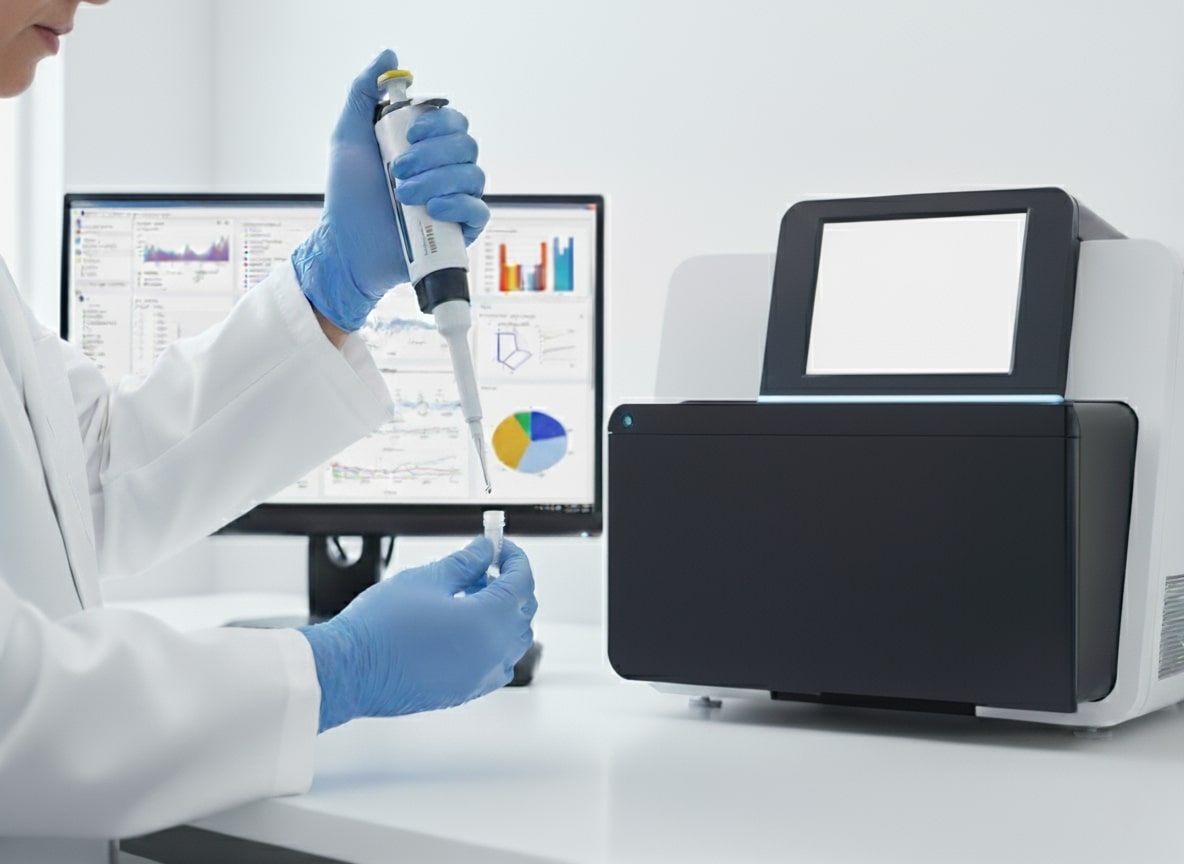As summarized in our previous article, solid tumors are abnormal tissue masses that develop in organs due to uncontrolled cell growth. Traditional biopsies, while informative, have significant limitations: they sample only a small portion of the tumor, can be invasive and risky, and provide just a single snapshot in time, making it difficult to monitor disease progression or therapy response. These challenges have driven the development of minimally invasive liquid biopsies, which enable repeated monitoring with reduced burden on patients. In this article, we explore current data on the use of liquid biopsy-based minimal residual disease (MRD) assessment in colorectal cancer, breast cancer, and lung cancer.
Colon and Colorectal Cancer
While colon cancer refers specifically to malignancies in the large intestine, colorectal cancer (CRC) is a broader term encompassing both colon and rectal cancers. Together, they represent one of the most common malignancies worldwide and shed a significant amount of ctDNA into the bloodstream [1]. CRC is most often diagnosed at an early stage (I–III), yet despite often multimodal treatment, 30–40% of patients experience recurrence, with around 80% of these relapses occurring within two years after surgery [4]. Here, monitoring MRD using ctDNA can help identify patients who may safely avoid unnecessary adjuvant chemotherapy and enable early intervention for patients at higher risk of recurrence [1,2]:
While the presence of ctDNA after resection does not reliably identify patients who would benefit from adjuvant chemotherapy [3], post-treatment ctDNA negativity helped identify patients who were recurrence-free and thereby avoided unnecessary chemotherapy [4]. Conversely, ctDNA positivity after definitive therapy or surgery flagged high-risk patients and predicted recurrence earlier (up to 9 months) before conventional imaging [5–9]. Moreover, the accuracy of ctDNA-based MRD testing can be further improved by integrating genomic and epigenomic data and performing serial measurements [10].
Breast Cancer
Breast cancer is a highly heterogeneous disease comprising multiple molecular subtypes that require distinct therapeutic approaches [1]. Despite major advances in early detection and systemic therapies also via key molecular markers [11,12]. [13], late recurrences remain a significant challenge. Circulating tumor DNA (ctDNA) has emerged as a promising biomarker for monitoring minimal residual disease (MRD) and guiding treatment in breast cancer [1].
Detection of ctDNA is consistently associated with poorer outcomes, including reduced overall survival, progression-free survival, and disease-free survival [14,15]. (Serial) ctDNA analysis can detect residual disease post-surgery, assess molecular response after therapy, and identify patients at high risk of recurrence earlier than conventional imaging (up to 5.7 years) [16–18]. Personalized and high-sensitivity serial ctDNA analyses can provide a lead time of several years before clinical or radiological relapse [16–19]. However, neoadjuvant chemotherapy can rapidly reduce ctDNA levels, which may result in an absence of detectable MRD immediately after surgery [20].
Lung cancer
Lung cancer remains a leading cause of cancer-related deaths worldwide [21]. It is a heterogeneous disease with different subtypes, comprising multiple subtypes, with non-small cell lung cancer (NSCLC) accounting for about 85% of all cases and small cell lung cancer (SCLC) representing the remaining fraction [21]. Early-stage NSCLC patients have a relatively favorable five-year survival rate of around 75%, but survival declines sharply in advanced stages, where stage III and IV tumors are often inoperable. Moreover, 20–50% of patients who undergo surgery eventually experience relapse, highlighting the need for early detection and rapid therapeutic intervention [22]. A major milestone in ctDNA-based diagnostics was achieved in 2016, when the first FDA-cleared liquid biopsy assay—a PCR-based test for NSCLC—was approved [23]. Since then, research has increasingly focused on the dynamic monitoring of ctDNA for dynamic disease monitoring, including assessing treatment response, detecting minimal residual disease (MRD), and guiding therapy decisions.
While ctDNA genotyping is already well established for treatment selection and therapy optimization in NSCLC [24–28], the sensitivity of ctDNA-based MRD assays for detecting recurrence after surgery or systemic therapy remains limited. Current assays still face challenges with false-negative results, particularly in stage I disease, showing sensitivities ranging between 15% and 61% [22]. Longitudinal monitoring and the inclusion of a larger number of mutations per patient can improve MRD detection rates, but performance remains highly dependent on assay technology and tumor stage [22,29]. Despite these limitations, the presence of ctDNA after tumor resection or adjuvant therapy consistently correlates with an increased risk of recurrence and reduced overall survival. Conversely, ctDNA clearance is associated with longer survival outcomes. These findings suggest that MRD detection via ctDNA could serve as a powerful surrogate marker for disease activity and a valuable prognostic tool in resectable NSCLC [22].
LIQOMICS
At LIQOMICS, we are offering CancerVista, a ctDNA-based MRD assay designed for reliable detection of minimal residual disease in solid tumors with high sensitivity and a low limit of detection. The assay is offered as an in-house IVD for genotyping and MRD monitoring in solid tumors. Please contact us for more information.
Literature
- Bartolomucci A, Nobrega M, Ferrier T, et al. Circulating tumor DNA to monitor treatment response in solid tumors and advance precision oncology. Npj Precis Oncol [Internet]. 2025 [cited 2025 July 10];9(1).
- Crisafulli G. Liquid Biopsy and Challenge of Assay Heterogeneity for Minimal Residual Disease Assessment in Colon Cancer Treatment. Genes. 2025;16(1):71.
- Morris VK, Yothers G, Kopetz S, et al. Phase II results of circulating tumor DNA as a predictive biomarker in adjuvant chemotherapy in patients with stage II colon cancer: NRG-GI005 (COBRA) phase II/III study. J Clin Oncol. 2024;42(3_suppl):5–5.
- Tie J, Cohen JD, Lahouel K, et al. Circulating Tumor DNA Analysis Guiding Adjuvant Therapy in Stage II Colon Cancer. N Engl J Med. 2022;386(24):2261–2272.
- Tie J, Wang Y, Tomasetti C, et al. Circulating tumor DNA analysis detects minimal residual disease and predicts recurrence in patients with stage II colon cancer. Sci Transl Med [Internet]. 2016 [cited 2025 Oct 16];8(346).
- Reinert T, Henriksen TV, Christensen E, et al. Analysis of Plasma Cell-Free DNA by Ultradeep Sequencing in Patients With Stages I to III Colorectal Cancer. JAMA Oncol. 2019;5(8):1124.
- Parikh AR, Van Seventer EE, Siravegna G, et al. Minimal Residual Disease Detection using a Plasma-only Circulating Tumor DNA Assay in Patients with Colorectal Cancer. Clin Cancer Res. 2021;27(20):5586–5594.
- Nakamura Y, Tsukada Y, Matsuhashi N, et al. Colorectal Cancer Recurrence Prediction Using a Tissue-Free Epigenomic Minimal Residual Disease Assay. Clin Cancer Res Off J Am Assoc Cancer Res. 2024;30(19):4377–4387.
- Kotani D, Oki E, Nakamura Y, et al. Molecular residual disease and efficacy of adjuvant chemotherapy in patients with colorectal cancer. Nat Med. 2023;29(1):127–134.
- Chen H, Zhou Q. Detecting liquid remnants of solid tumors treated with curative intent: Circulating tumor DNA as a biomarker of minimal residual disease (Review). Oncol Rep. 2023;49(5):106.
- Walsh MF, Nathanson KL, Couch FJ, et al. Genomic Biomarkers for Breast Cancer Risk. Adv Exp Med Biol. 2016;882:1–32.
- Mohanty SS, Sahoo CR, Padhy RN. Role of hormone receptors and HER2 as prospective molecular markers for breast cancer: An update. Genes Dis. 2022;9(3):648–658.
- Peto R, Boreham J, Clarke M, et al. UK and USA breast cancer deaths down 25% in year 2000 at ages 20-69 years. Lancet Lond Engl. 2000;355(9217):1822.
- Xu J, Gao H, Guan X, et al. Circulating tumor DNA: from discovery to clinical application in breast cancer. Front Immunol. 2024;15:1355887.
- Dickinson K, Sharma A, Agnihotram R-KV, et al. Circulating Tumor DNA and Survival in Metastatic Breast Cancer: A Systematic Review and Meta-Analysis. JAMA Netw Open. 2024;7(9):e2431722.
- Coombes RC, Page K, Salari R, et al. Personalized Detection of Circulating Tumor DNA Antedates Breast Cancer Metastatic Recurrence. Clin Cancer Res. 2019;25(14):4255–4263.
- Comino-Méndez I, Velasco-Suelto J, Pascual J, et al. Identification of minimal residual disease using the clonesight test for ultrasensitive ctDNA detection to anticipate late relapse in early breast cancer. Breast Cancer Res. 2025;27(1):65.
- Janni W, Rack B, Friedl TWP, et al. Detection of minimal residual disease and prediction of recurrence in breast cancer using a plasma-only circulating tumor DNA assay. ESMO Open. 2025;10(4):104296.
- McDonald BR, Contente-Cuomo T, Sammut S-J, et al. Personalized circulating tumor DNA analysis to detect residual disease after neoadjuvant therapy in breast cancer. Sci Transl Med. 2019;11(504):eaax7392.
- Riva F, Bidard F-C, Houy A, et al. Patient-Specific Circulating Tumor DNA Detection during Neoadjuvant Chemotherapy in Triple-Negative Breast Cancer. Clin Chem. 2017;63(3):691–699.
- Thai AA, Solomon BJ, Sequist LV, et al. Lung cancer. The Lancet. 2021;398(10299):535–554.
- Boukouris AE, Michaelidou K, Joosse SA, et al. A comprehensive overview of minimal residual disease in the management of early-stage and locally advanced non-small cell lung cancer. Npj Precis Oncol. 2025;9(1):178.
- Barr MP, Baird A-M, Halliday S, et al. Liquid Biopsy: A Multi-Parametric Analysis of Mutation Status, Circulating Tumor Cells and Inflammatory Markers in EGFR-Mutated NSCLC. Diagn Basel Switz. 2022;12(10):2360.
- Peters S, Dziadziuszko R, Morabito A, et al. Atezolizumab versus chemotherapy in advanced or metastatic NSCLC with high blood-based tumor mutational burden: primary analysis of BFAST cohort C randomized phase 3 trial. Nat Med. 2022;28(9):1831–1839.
- Dziadziuszko R, Mok T, Peters S, et al. Blood First Assay Screening Trial (BFAST) in Treatment-Naive Advanced or Metastatic NSCLC: Initial Results of the Phase 2 ALK-Positive Cohort. J Thorac Oncol. 2021;16(12):2040–2050.
- Dziadziuszko R, Peled N, Mok T, et al. High-dose alectinib for RET fusion-positive non-small cell lung cancer in the Blood First Assay Screening Trial. Współczesna Onkol. 2023;27(4):217–223.
- García-Pardo M, Czarnecka-Kujawa K, Law JH, et al. Association of Circulating Tumor DNA Testing Before Tissue Diagnosis With Time to Treatment Among Patients With Suspected Advanced Lung Cancer: The ACCELERATE Nonrandomized Clinical Trial. JAMA Netw Open. 2023;6(7):e2325332.
- Dong S, Wang Z, Zhang J-T, et al. Circulating Tumor DNA-Guided De-Escalation Targeted Therapy for Advanced Non−Small Cell Lung Cancer: A Nonrandomized Controlled Trial. JAMA Oncol. 2024;10(7):932.
- Chaudhuri AA, Chabon JJ, Lovejoy AF, et al. Early Detection of Molecular Residual Disease in Localized Lung Cancer by Circulating Tumor DNA Profiling. Cancer Discov. 2017;7(12):1394–1403.



